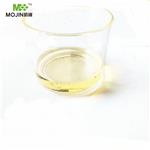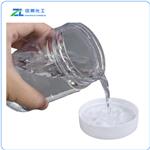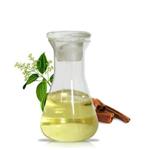Herbaceous grasses that grow wild in several tropical and subtrop ical regions. The East Indian variety is grown in eastern India,
Cambodia, Singapore, and Ceylon. The West Indian type is grown
in Madagascar, the Comoro Islands, Guatemala, Honduras, Brazil,
Haiti, and Puerto Rico. The East Indian variety yields an alcohol
soluble oil (1:2 in 70% alcohol); West Indian lemongrass is soluble 1:10 in 90% alcohol with haze. The part used is the herbaceous
portion. Lemongrass has a strong, pungent, lemon-like odor.
The essential oil is obtained by steam distillation of freshly cut
(East Indian variety) or partially dried (West Indian variety) grass
in approximately 0.2 to 0.3% and 0.31 to 0.37% yields, respec tively.
East Indian Lemongrass Oil: East Indian lemongrass oil is a
pale-yellow to brown-yellowish liquid; it has a characteristic,
sharp, pungent, lemon-like odor because of the large amount of
citral present (80 to 85%).
In addition to citral, the main constituents of the East Indian oil
include citronellal, geraniol, nerol, famesol, dipentene, methylhep tenone, and probably limonene.
West Indian Lemongrass Oil: West Indian lemongrass oil is a
pale-yellow to brownish liquid with a pronounced citral odor. Its
physical-chemical constants are as follows.
Its main constituents include isovaleric aldehyde, furfural, myrcene,
dipentene, methylheptenone, aldehyde C10, citronellal, various esters,
linalool, geraniol, nerol, and terpenes.
Constituents include: andrographolide; andrographidin A; andro graphidin B; andrographidin C; andrographidin D; andrographidin
E; andrographidin F; andrographin; andrographinin; andrographi side; andropanoside; apigenin-4,7-di-o-methyl ether; gamma-bis abolene; caffeic acid; carvacrol; chlorogenic acid; deoxyandro graphiside; dicaffeoyl quinic acid; 5-dihydroxy-7,8-dimethoxy flavone; eugenol; 2-cis-6-trans-famesol; 2-trans-6-trans-farnesol;
5-hydroxy-7,8-dimethoxyflavone; 5-hydroxy-2,3,7,8-tetrameth oxyflavone; myristic acid; oroxyline A; panicolin; paniculide B;
and sitosterol-α-1.
The oil is obtained by steam distillation of freshly cut (East Indian variety) or partially dried (West Indian variety)
grass in approximately 0.2 to 0.3% and 0.31 to 0.37% yields, respectively. East Indian lemongrass oil is a pale-yellow to brown-yellow
liquid. It has a characteristic, sharp, pungent, lemon-like odor because of the large amount of citral present (80 to 85%). West Indian
lemongrass oil is a pale-yellow to brownish liquid with a pronounced citral odor as well.
Herbaceous grasses that grow wild in several tropical and subtropical regions. The East Indian variety is grown in
eastern India, Cambodia, Singapore and Sri Lanka. The West Indian type is grown in Madagascar, the Comoro Islands, Guatemala,
Honduras, Brazil, Haiti and Puerto Rico. The part used is the herbaceous portion. The freshly cut and partially dried leaves are used
medicinally. Lemongrass has a strong, pungent, lemon-like odor
West Indian or Guatemala lemongrass oil is obtained from Cymbopogon
citratus (DC. ex Nees) Stapf in Central and South America. Guatemala produces ~50 t/yr. It is a pale yellow to orange-yellow liquid with a lemon-like odor, characteristic of citral.
d2020 0.872–0.900; n20D 1.483–1.489; α20D ?6 ° to 0 °; content of carbonyl
compounds (calculated as citral): min. 75%; citral content by GC: 31–40%
neral and 40–50% geranial; solubility: freshly distilled oil is soluble in 70%
ethanol at 20 ℃, but solubility diminishes on storage, and the oil may
become insoluble in 90% ethanol.
Found in the grasses of Cymbopogon citratus (Stapf) and Andropogon nardus var. ceriferus
lemongrass oil (Cymbopogon citratus) is considered astringent and tonic, it has also exhibited anti-fungal properties. It is widely used in the perfume and soap industries. Lemongrass oil is the volatile oil distilled from the leaves of the lemon grasses.
Lemongrass oil can be used as a flavoring agent in the food, perfume, and cosmetic industries.
By steam distillation of the freshly cut and partially dried grasses
Extractives and their physically modified derivatives. Cymbopogon citratus or Cymbopogon flexuosus, Gramineae.
Essential oil composition
The main constituents include isovaleric aldehyde, furfural, myrcene, dipentene, methylheptenone, citronellal,
various esters, linalool, geraniol, nerol and terpenes.
Essential oil composition
The oil from C. citrates mainly contains a mixture of two isomers of citral (65 to 82%), geraniol (56 to 61%)
and neral (31%). Other compounds include myrcene (20%), geraniol, diterpenes, alcohols, aldehydes and other minor fragrant components.
The citral content from many species varies. East Indian lemongrass is reported to contain no citral, but up to 30% borneol.
Taste characteristics at 0.25%: green, citrus, lemon, floral, linalool, spice and chamomile-like
Lemongrass oil is a volatile oil with a fresh grassy lemon-like aroma. It is generally obtained from the lemongrass leaves. Lemongrass oil is usually composed of geranial up to 60%, neral up to 30%, geraniol up to 4%, limonene, and linalool.


